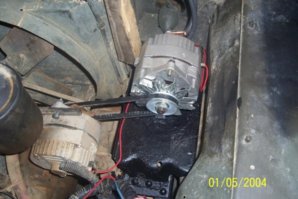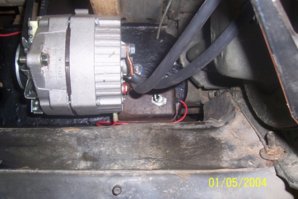buckshot500
Well-Known Member
- Joined
- Mar 23, 2008
- Location
- Clover S.C.
HOLY CRAP!!!!
I stopped in at Black's alternator today. After a quick explanation, Steve told me I was wasting my time & should just go buy a welder. Then I mentioned I wanted it to be in my jeep, so I could weld anywhere I could drive the jeep to.
I said they do make a nice setup that uses an alternator, but that it was about $1000.00. So he showed me some large frame Ford alts, & then I asked him about the Leece-Neville deal.
He brings out two monstrosities & throws 'em on the counter.
The 160 amp unit would be $200.00, & the 190 amp one would be $300.00.
He could redo a LG frame Ford for like $150.00 to be like 130-140 amps.
Then he digs under the counter & says I just remembered this thing.
It's a Leece knock off & he's not allowed to sell it because they weren't able to regulate the voltage in it. It's 220 amps! (My use requires that it not be regulated)
Only thing is, he cant get a replacement winding if I fry it. Diodes not a problem, he can replace those any time.
Then he says "I'm gonna make your whole day!" I'll rewire it the way you'll need it, & you can have it for $150.00.
I took a few minutes to think it over & pulled the trigger on it.
It'll be ready Monday afternoon, if I am off from work I'll go get it. Otherwise I'll get it one day next week.
(Now I know what your thinking, how's Bucky gonna buy something instead of getting it from the junkyard.
Well even though it's brand new, I still see it as a redneck mod, 220 amp welder in a jeep! Hells yeah!)
He said I can spin it with no load, as long as I haven't energized the field wire.
I'll need to put a switch & a rheostat on that line. The deal I'm going with, will have it removed & packed in an onboard box, with the other welding equipment. When I need it, I just throw it up on the pivot & put the belt on & tighten it up.
Start the engine & get ready to weld. Right before I strike the arc, I throw the switch. When I stop welding for a length of time greater than changing a rod, I switch off the field. This should prevent it from frying itself.
I forgot to ask him if it had a provision for A.C., but I'll find out when I pick it up. (Ooh TIG Aluminum trailside!) !Click the image to open in full size.
220 amps should be more than enough to run 5/32" E6010, & 1/8" E7018
1/8" cutting rods too.
I stopped in at Black's alternator today. After a quick explanation, Steve told me I was wasting my time & should just go buy a welder. Then I mentioned I wanted it to be in my jeep, so I could weld anywhere I could drive the jeep to.
I said they do make a nice setup that uses an alternator, but that it was about $1000.00. So he showed me some large frame Ford alts, & then I asked him about the Leece-Neville deal.
He brings out two monstrosities & throws 'em on the counter.
The 160 amp unit would be $200.00, & the 190 amp one would be $300.00.
He could redo a LG frame Ford for like $150.00 to be like 130-140 amps.
Then he digs under the counter & says I just remembered this thing.
It's a Leece knock off & he's not allowed to sell it because they weren't able to regulate the voltage in it. It's 220 amps! (My use requires that it not be regulated)
Only thing is, he cant get a replacement winding if I fry it. Diodes not a problem, he can replace those any time.
Then he says "I'm gonna make your whole day!" I'll rewire it the way you'll need it, & you can have it for $150.00.
I took a few minutes to think it over & pulled the trigger on it.
It'll be ready Monday afternoon, if I am off from work I'll go get it. Otherwise I'll get it one day next week.
(Now I know what your thinking, how's Bucky gonna buy something instead of getting it from the junkyard.
Well even though it's brand new, I still see it as a redneck mod, 220 amp welder in a jeep! Hells yeah!)
He said I can spin it with no load, as long as I haven't energized the field wire.
I'll need to put a switch & a rheostat on that line. The deal I'm going with, will have it removed & packed in an onboard box, with the other welding equipment. When I need it, I just throw it up on the pivot & put the belt on & tighten it up.
Start the engine & get ready to weld. Right before I strike the arc, I throw the switch. When I stop welding for a length of time greater than changing a rod, I switch off the field. This should prevent it from frying itself.
I forgot to ask him if it had a provision for A.C., but I'll find out when I pick it up. (Ooh TIG Aluminum trailside!) !Click the image to open in full size.
220 amps should be more than enough to run 5/32" E6010, & 1/8" E7018
1/8" cutting rods too.







